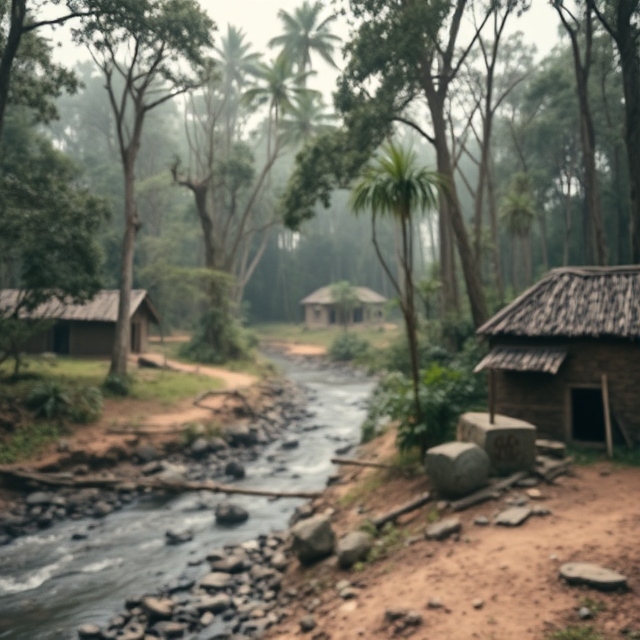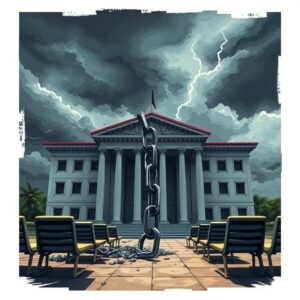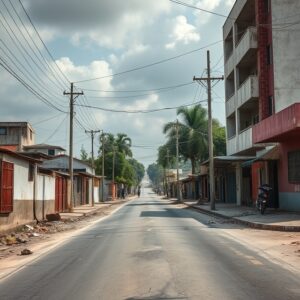The Mystery of Olayinka’s Vanished Residents

Dense forest surrounding an empty village with abandoned homes and ancient symbols carved into stone.
The Disappearing Village: The Mystery of Olayinka’s Vanished Residents
The day the first report came, it felt almost like a bad dream. News had started spreading through the small town of Ikire about a village nearby where all the residents had seemingly disappeared. The village of Olayinka, nestled a few miles from the main road and surrounded by dense forest, was now completely empty. It sounded like the kind of story meant to be buried in whispers, but this one carried an edge—a sharp unease that refused to be ignored.
The first person to raise the alarm was Chief Odewale, a respected leader in the area. His tone during the meeting at his town hall was cautious but firm. “Olayinka is not just another small village. There is no way such a thing could happen overnight without anyone knowing.” His words, though simple, hung in the air like a heavy question.
What followed was a stream of speculation. Some villagers spoke of abandonment caused by famine. Others whispered about ancient curses from forgotten ancestors. Yet others believed something far more sinister lurked in the dark trees surrounding the village.
Despite these speculations, nobody could deny that Olayinka was empty. Government officials, journalists, and the curious alike began making their way toward the village to uncover its secrets. Yet the more they looked, the less they found.
It all started to unravel with a series of searches through local paths. The village’s traditional landmarks—its ancient baobab tree, the local mosque, the small community center—were there, but they were eerily vacant. Homes that had stood for generations appeared undisturbed, their doors swinging lazily in the breeze. No footprints, no signs of life.
Detective Adebayo was one of the first officials to visit the area. His gut told him that this wasn’t a simple case of famine or abandonment. During his first visit, he noticed oddities. The way paths were swept clean, the way even the smallest traces of daily life—discarded food wrappers, wood carvings, or tools left in haste—were absent.
One local elder, who refused to give his name, said in hushed tones, “They took them. Not by war, not by disease. Something took them, and it wasn’t man.”
Detective Adebayo didn’t know how much stock to put into stories like that, but as the days went on, the absence of information began gnawing at him. His investigations led him to old books in the archives and local oral histories, focusing on Olayinka’s history and its people. What he found did not help him sleep at night.
Some ancient records suggested that Olayinka had suffered through famines and wars centuries ago. However, none of those stories explained a sudden disappearance of every single person from a settlement of about 200 residents. The elders didn’t know much more either. They spoke only of how “bad omens” tended to show themselves before disasters, warnings ignored or misinterpreted by stubborn villagers.
The twists came when a local historian traced the village’s founding back to old river settlements. He found mention of a group of settlers moving into the area with rituals, dedicating themselves to their gods and ancestral spirits. There were old mentions of Olayinka being “guarded by spirits,” but the historian himself could not say whether these beliefs were history or myth.
The breakthrough came when the search team began uncovering strange remnants at the village’s outskirts. There were half-familiar symbols carved into stones near the riverbanks—symbols no one could completely identify. These weren’t symbols for farming or community—they were ritualistic, archaic patterns, buried in weathered earth and partially hidden by moss.
An archaeologist who was brought in for the investigation took one look at them and confirmed they belonged to ancient Yoruba rituals. It was at this point that the suspicions of some villagers began turning into fears: a belief that the village had vanished due to ancient curses or retribution.
Detective Adebayo stood at the riverbank one afternoon with the historian and the archaeologist. The trees loomed quietly around them, their leaves making only the faintest sound. It felt as if the entire forest were listening, waiting.
“This could explain part of it,” the archaeologist said. His voice was calm but confident. “The symbols suggest that there was a kind of ritual performed here. My guess is that it might have led to Olayinka either being abandoned or the people disappearing for reasons they couldn’t control.”
But Adebayo wasn’t convinced by ancient curses or myths. His mind was racing with other possibilities. He wondered if a disease had gone unnoticed, or if it could have been violence. But everything came back to silence—no bodies, no signs of struggle, just empty homes and empty streets.
The villagers remained anxious. Olayinka’s neighbors began speaking about strange noises at night—unexplained sounds coming from the direction of the missing village. Some said they could hear faint cries, though nobody could confirm where they came from. Some nights, people swore they could see lights in the trees, faint and golden, but none could explain them.
A team of soldiers was dispatched to patrol the area, but they found nothing except dense wilderness and quiet villages. Their presence brought no answers. Rumors began to spread that perhaps drug traffickers or even rebel groups could have forced the entire population into hiding, though there were no clear signs of this.
Weeks turned into months as the investigation continued. Olayinka’s mystery never unraveled. While there were theories about abductions, ancient curses, or unacknowledged natural disasters, the truth remained just out of reach.
Detective Adebayo would often return to that riverbank, staring at the symbols, trying to make sense of them. His belief in logic clashed with the eerie feeling of unease. There was something about Olayinka, something deeply hidden, that felt far too large to be explained by simple logic or crime.
The village remained empty, but its story lingered. Stories of the missing residents spread further, both through news reports and whispered conversations. Some feared what would happen if the truth was ever found, while others hoped the mystery would remain buried forever.
As time passed, Olayinka was no longer just a village. It became a symbol—a puzzle, a mystery, a story people spoke of in hushed tones. Some said it was cursed, others said it was an unsolved crime. But in the end, nobody could say for sure.
The village stayed empty, and its people stayed missing, swallowed by history, silence, and uncertainty.
Nobody could answer the question of whether Olayinka would ever be found or if its residents would ever return. But their story remained a mystery, lodged deep in the hearts of the townspeople.







